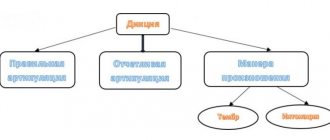How to develop a child's speech
We continue the conversation about the development of a child’s speech , which began in the first part of the article devoted to this problem.
The movements of the body and organs involved in speech production have common mechanisms, therefore the development of fine motor skills of the hands directly affects the development of speech. It is for this reason that finger exercises for the development of speech in children should take a strong place in your activities with your child.
Training finger movements will, as it were, prepare a platform for further speech development. You can start training your baby’s fingers within the first 5 months.
Now let's see how you can help your child master their native speech, teach him correct pronunciation, constructing phrases and forming thoughts.
Remember: classes should be held in the most easy, fun and playful way possible. Then they will bring real benefits and bring real pleasure to both of you.
A set of measures for speech development (to be carried out at home):
- Development of fine motor skills
- Speech gymnastics
- Logorhythmics
We do not mention here such areas of work on speech development as speech therapy massage, special exercises for practicing various sounds, developing phonemic hearing, and some others. They are the area of application of exclusively professional knowledge and skills. Here it is better to trust a specialist rather than try to cope with this task yourself.
Benefits for developing fine motor skills:
- Matryoshka dolls
- Velvet paper
- Plasticine
- Mosaic
- Laces
- Beans, peas
- Semolina
- Salty dough
- Counting sticks
- Multi-colored clothespins
- Beads
- Cloths with sewn buttons
- Stencils
- Massage ball
- Wooden construction sets
Fine motor skills:
- Passive gymnastics - massage for the development of fine motor skills.
- Active gymnastics - games for the development of fine motor skills: poems and nursery rhymes, finger games, finger theater.
Games for developing speaking skills
The basis for such games is ordinary speech. The child gains useful experience of fluent and grammatically correct spoken language. Games are useful for stimulating positive emotions if a child has isolated himself, withdrawn, or become offended.
"Skilled rhymers." It is useful to turn to such a game when you are offended by a peer, brother or sister.
Make up, make up, make up and don’t fight anymore, and if you fight, you’ll be left without a friend.
* Hey, hand, shake, shake, just don’t fight anymore.
* Relax your hand, relax and don’t pinch anymore.
* Oh, my hand is stuck! I let go of my hand and grab him by the body. You call it good, I let go of my hand.
Playful rhymes to help you overcome feelings of resentment.
Take away the insult - you are forgotten anyway,
Run into the yard, climb over the fence,
Get on your horse and ride away from me!
Passive gymnastics (massage)
It is better if an experienced professional shows you the massage technique, but you can master the simplest techniques yourself.
The massage is performed with one hand, the other holds the massaged hand. Session duration: 3 – 5 minutes; carried out several times a day.
Massage includes the following types of movements:
- Stroking - performed in different directions;
- Rubbing - differs from stroking with a greater force of pressure (the hand does not slide over the skin, but moves it);
- Vibration - applying frequent blows with the tips of half-bent fingers;
- Massage using a special ball - with the ball you need to make movements in a spiral from the center of the palm to the tips of the fingers; practical advice: you need to use a hard ball, that is, it should not be easily deformed (then the impact will be maximum);
- Flexion-extension of the fingers - the fingers are initially clenched into a fist, each in turn is extended and massaged from the side of the palm in a circular motion from the base to the tip.
Sample activities:
I would like to note that the set of classes on the site is not complete and is for informational purposes only. If you want to get full a set of game activities for speech development for children 5-7 years old then write by email or feedback mail.
A set of game activities for speech development for children aged 5-7 years is presented in a Word document in black and white. This is very convenient, because... The training material can be easily printed and modified if desired.
Active gymnastics: games for developing speech using fine motor skills
Game aids:
- Butterflies made of colored paper
- Leaves of colored paper
- Pinwheel
- Cotton balls
- Paper boat
Games for children from 2 months:
- That's how different they are. Objects of various textures and shapes are placed in the child’s hand. The baby must grab the object and hold it for a while. This exercise develops not only motor skills, but also tactile sensations. It’s good if you comment on what is happening: “This ball is smooth,” “This hedgehog is prickly,” etc.
Games for children from 9 months
- Prefabricated nesting dolls. First you need to collect one doll, then gradually complicate the game; after 2 years it should be a triple matryoshka.
- Pyramids. First you need to use a classic pyramid, the size of the rings of which decreases towards the top.
- Trace along the outline. You need to make cards with images of objects known to the baby, for example, a house, a tree, a car, and paste over their outlines with velvet paper. The essence of the game: an adult guides the baby’s finger along the contour and names the object. Then the outline is covered with beads or peas and the game is repeated.
- Cups and spoons. The child uses a spoon to pour sugar or semolina from one cup to another. You can also transfer beans, peas or nuts by hand.
- Modeling from plasticine. You need to start with a cylinder, and over time complicate the tasks: a ball, a carrot, a snake.
During the games, do not forget to comment on your actions and explain to your child everything that you do.
Games for children from 1 year:
- Strong palms. The child squeezes rubber toys. The best thing is the rubber hedgehog: the needles act like a massager.
- Mosaic. First you need to lay out simple shapes: paths, flowers, squares, and then move on to more complex ones: houses, cars, Christmas trees.
- Constructor. The size of the parts and the complexity of the design depend on the age of the baby: you need to start with the largest parts and the simplest structures, for example, building a turret.
- Beads. The size of the beads also depends on the age of the child. First, instead of beads, you can use balls from pyramids with round parts and string them on a thick cord; then the size of the parts must be gradually reduced, moving on to real beads. For the exercise, medium-sized beads already strung are used. The goal is to teach the child to lay out the outlines of objects from beads. For example, you can lay out a circle, square, heart, spiral, etc.
- Laces. Since lacing has different contents, it makes sense to play with the lacing process - for example, ask the child to sew a dress for his mother (lace-button) or lace shoes (lace-boot).
- Magic tray. Sprinkle a thin layer of semolina onto a tray and run the child’s finger over the cereal. The child is then shown how to draw various shapes. At the age of 2 - 3 years, you can draw numbers and letters.
- Multi-colored clothespins. The essence of the game is to teach the child to independently attach clothespins, and to make the game interesting, you can do this according to a thematic principle: rays to the sun, needles to the hedgehog, rain to the cloud, grass to the ground. Of course, for this you first have to make preparations. This is a rather difficult task for a child. Don't try to achieve results right away. To begin, take the baby’s hands in yours and do the exercise with him.
- Cinderella. You need to mix white and red beans and ask your child to sort them by color.
- Funny pictures. Spread the plasticine evenly over a sheet of cardboard and show your child how to lay out drawings using peas.
- Counting sticks. Show your child how to use counting sticks to lay out different shapes. It is advisable that the counting sticks are not smooth, but ribbed: this serves as an additional massage for the fingers.
- Little sculptor. Dough modeling (dough recipe: 1 cup flour, 1/2 cup salt, a little water). The advantage of dough over plasticine in this case is that the crafts can subsequently be used as toys.
- Fasten the button. You will need two pieces of thick fabric. On one of them, sew three buttons of different diameters, in the second, cut loops of appropriate size. First, show your child how to fasten the buttons, commenting on your actions: “We insert the large button into the large buttonhole, the medium button into the middle one, and the small button into the small one.” Then take the child's hands in yours and repeat the exercise. After this, you can invite the baby to try to fasten the buttons on his own. Don’t insist if the baby doesn’t want to or if he can’t do it. This is a very difficult exercise and requires practice to perform successfully.
- Stencils. It is recommended to start with stencils for internal tracing (it is easier for a child to trace inside than outside) and with the simplest shapes (circle or square). Practical advice: you can buy ready-made stencils, but it is better to make them yourself. The fact is that most standard stencils are small in thickness, and it is inconvenient for a child to trace them, since the pencil keeps slipping off. Therefore, the stencils must be quite voluminous. A good solution is to cut them out of a piece of linoleum or a shoebox.
How to continue your child's education
What happens next?
And then we teach the child to use what he has accumulated, that is, to express his thoughts correctly and coherently - to explain, prove, build a narrative logic and compose. This is a more complex process that goes beyond everyday speech and is related to verbal creativity. Future works take their origins here. Let's start this stage with the basics - the ability to compose a short story about any living or inanimate object or item. In the future, this kind of information will be useful for your first-grader to prepare reports: after all, very often it is the inability to correctly manage a large amount of information that leads to the fact that the child finds it difficult to start a story, to compose a story from a picture. This process is comparable to the question from adult life: “How are you?”, when you can talk at length and in various ways on the proposed topic, but most limit themselves to the answer: “Fine.” Let's use diagrams - these universal maps, which are clear step-by-step instructions and do not allow you to stray from the right path of word creation, at the same time, eliminating repetitions and hesitations in speech.
What is a story outline? Who → Which group does it belong to → Description → Where does it live → What does it eat → What benefits does it bring → Features
For example, here is a story about a dog that can be compiled according to this scheme:
“A dog is a pet. The appearance of a dog depends on the breed. Dachshunds are small, with a long body, elongated muzzle and long tail. Their legs are short. These dogs are designed for hunting foxes in narrow holes. Boxers have a flattened muzzle, a wide chest, and strong paws - they are a fighting breed. In villages, dogs live outside in a kennel. In cities, dogs are kept in apartments. They eat meat and special food. Since ancient times, the dog has been a friend and indispensable assistant to man. She helped him guard the house, herd sheep, hunt wolves, foxes, birds, and saved people both on the water and in the mountains. There are special guide dogs for the blind.”
A similar scheme applies to inanimate objects. What → Which group does it belong to → Parts → What is it made of → What is it used for
After the child has learned to compose descriptive stories, you can move on to the next stage - learning to compose stories based on a series of pictures. What is important here is the ability to build a logical chain: arrange the pictures in the correct order, because all our actions in ordinary life are carried out according to certain patterns.
It is important to convey to the child that pictures and the events taking place in them are not abstract stories, but what surrounds the child in everyday life. Let the child identify himself with the main character. He will tell you what he would feel, say and do in the character’s place. Let him give his name and the names of his friends to the children drawn.
Let the child tell you the rules of playing hide and seek, tag, what you need to do to brush your teeth, boil water in a kettle, or go down to the first floor.
It is very important to expand your child’s horizons, talk about everything that surrounds him - this will greatly help enrich your baby’s vocabulary and quickly develop full-fledged literate speech. Try to visit different places with your child, try as many different things as possible, play a variety of games. For example, if a child has never been fishing, he will not be able to write a story about the fun adventures of fishing boys on a river, since there are different laws and terminology here.
Then we teach the child to write stories based on the pictures. Let's use our imagination and turn one picture into a series of three, mentally imagining the beginning and then the ending of our story.
And the last stage - the most difficult - is the ability to compose a story-description of nature from a picture. At first glance, there is no action, no heroes, just one forest. But, closing your eyes and stepping out of reality into the very thicket of an imaginary forest, you discover that life here is in full swing. In order not to get lost in this thicket, again, a diagram-description of the signs of the seasons will come to our aid.
Day and Night → Weather → Flora → The world of birds, animals, insects.
Here is an example of a story about autumn, compiled according to this scheme:
“In autumn, the days become shorter and the nights longer. At the beginning of autumn the days are fine. This time is called “Indian summer”. But then the sky frowns, becomes cloudy and the tedious rain drizzles all day long. A piercing cold wind is blowing. The trees dress up in painted clothes - yellow, red, orange, purple. The wind will blow and a colorful rain of leaves will fall from the trees. Autumn is the time of leaf fall. Birds gather in flocks and fly away to warmer regions. Animals are preparing to hibernate, fattening up, and storing food for the winter. Squirrels and hares change their summer coats for winter ones.”
Finger Theater
Finger theater is an exciting game that:
- Stimulates the development of fine motor skills;
- Introduces the child to the following concepts of shape, color, size;
- Helps develop spatial perception (the concepts of “right”, “left”, “next to each other”, etc.);
- Develops imagination, memory, thinking and attention;
- Helps develop vocabulary and activates speech functions;
- Forms creative abilities and artistic skills;
- Introduces basic mathematical concepts.
For children aged 1 – 2 years (using the example of the fairy tale “Kolobok”):
- First, introduce your child to the characters in the fairy tale. Invite your child to look at and touch the figures. Then put each character on your finger in turn and describe it.
- Introduce your child to the name of each finger on his hand. For example, you can say this: “I have a Kolobok sitting on my index finger.”
- Then act out a fairy tale for your child. Place the characters on your fingers and cross your arms. Start telling the story, raising your fingers with the characters as the action progresses. For example, the fairy tale “Kolobok” can be told as follows. Thumbs up with Grandma character. Tell your child that today this hero will bake Kolobok. Rhythmically tap the heels of your palms against each other without releasing your fingers. At the same time, say: “Grandma is kneading the dough.” Using the same principle, play up the appearance of each character.
For children aged 2 – 4 years (using the example of the fairy tale “Kolobok”):
- Ask your child if he remembers the fairy tale “Kolobok”. Remind him if necessary.
- Then ask your child to place the characters on the table in the order they appear in the story. At the same time, ask to characterize each of them according to the principle: “Grandma is old, kind, caring; Kolobok is round, ruddy, mischievous,” etc.
- Ask your child questions about the fairy tale. For example: “Why did grandma decide to bake Kolobok? Why did he leave his grandmother and grandfather? Who did he meet on the way?
- Then act out a fairy tale in front of the little spectator using a finger theater.
- At the end, ask your child to act out a fairy tale in front of you using a finger theater. If necessary, prompt him.
And finally - communication with the child
During preschool, a child's natural environment is play, so turn learning into play. Exercise, that is, communicate while walking, on the way to the garden, to the store. Don’t sit at the table at home, like at school: just let your child look through the book, and complete the task that interests him, together. If your child is motivated to study, then, on the contrary, you can play school with him. In any case, be guided by the individual characteristics of your child, find an approach to him, and he will respond to you with interest, receptivity and understanding.
Listen carefully to your child, do not interrupt or rush him, do not scold him or compare him with others. Practice when your child is in a good mood, has had enough sleep and is not hungry.
Russian, like any other language, requires regularity, so it is better to study every day for 15-20 minutes than once a week for an hour. When our children begin to learn a foreign language, we understand that only regular classes can guarantee results and effectiveness; learning the Russian language and developing speech is also no exception and requires a systematic approach.
From an early age, it is necessary to teach a child to speak not only in the language of everyday life, but to use all the richness of the Russian language in his speech. Communication is one of the basic human needs, and your baby needs it like no other. Everyone has the opportunity to create, and we can do this every minute, creating small verbal masterpieces. Language is not only one of the most important means of communication, but also a living material that has its own color, shape and taste. We have to reveal this to children, teaching them to create within the framework of certain laws. This is a long path, and it depends on us, adults, whether they will take a narrow wandering path or a wide road on the path to new knowledge, discoveries and free communication.
We recommend reading:
- T.Yu. Bardysheva, T.A. Chokhonelidze "Retellings and Stories".
- T.A. Tkachenko “Big book of tasks and exercises for the development of coherent speech of a child.”
Finger games for speech development
The essence of the finger motor skills lesson is to teach the child to use his fingers to depict some objects or living beings. In this case, all finger movements must be explained to the baby. This will help the child understand concepts such as “top”, “bottom”, “right”, “left”, etc. After the child learns how to do the exercises himself, you can try to act out scenes or short fairy tales, distributing the roles among yourself and your little actor (for example, a meeting between a hedgehog and a bunny in the forest). Here are some examples of such exercises.
- Finger game “Bunny”. The index and middle fingers are straightened, the rest are clenched into a fist. Little man. “Run” with your index and middle fingers on the table. Finger game “Hedgehog”. Clasp your hands, straighten the fingers of one hand and the thumb of the other. Cat. Connect the middle and ring fingers with the thumb, raise the index and little fingers up. Horned goat. The index and little fingers are straight, the thumb is on the bent ring and middle fingers. Butterfly. Cross your hands at the wrists and press your palms with the backs of your hands facing each other, fingers straight; palms with straight fingers make slight movements in the wrists - “butterfly flies.” Glasses. Fold the fingers of your right and left hands into rings and bring them to your eyes.
In addition to these examples, you yourself can come up with many interesting and entertaining exercises for your child to develop speech.
Exercises and games for children 5 years old
At this age, more attention is paid to the components of the word - sounds. The child learns to determine by ear whether a given sound is present in a word. The baby distinguishes between similar and different words by sound. All this contributes to the development of speech. When performing exercises and games for children, include dialogues in the story, diversify the actions of the characters.
Game "first sound"
Invite your child to choose from several toys and ride in the car only those whose names begin with a certain sound, for example: k - doll, cat, clown. If a child chooses the “wrong” toy (for example, a dog), the car will not move. Explain that in the word “dog” the “k” sound is in the middle of the word, not in the first place.
Game "Who's Lost?"
Teach your child to form words with the same root and find synonyms for words. Encourage your child to think and reason. Imagine this plot situation: a hare is lost in the forest. Call it affectionately: bunny, bunny. Where is he, why is he crying? Lost, lost, wants to eat. What is he like? Sad, hungry, sad. How can I help him? Cure, calm, feed. The child suggests a possible description of the hare.
Game "Let's make up a story"
Together with your child, you can dream up and come up with a story. In the process, the child will understand the sequence of the story, the logical structure of the story. Suppose, for example, that a squirrel went into the forest and met a wolf. What is she like? Nimble, brave. And the wolf? Angry, angry. Then the adult begins to tell the story, and the child continues: the squirrel went out for a walk... and to pick up nuts, she climbed... into a tall tree, and there were nuts... apparently or invisibly, there was... a wolf coming towards her, but she... wasn’t scared, and threw a nut... right at the wolf .
Speech therapy for children: tips and exercises
Some children have a problem: they can speak, but their speech is intermittent. Children cannot express their thoughts using complete sentences: their words and even syllables “break”. These children may stutter or have slurred speech.
These problems interfere with the child's communication and can sometimes cause him to lack self-confidence. However, they can be addressed through speech therapy. Let's look at what it is and what games and activities can be used at home to eliminate speech problems in a child.
What is speech therapy
Speech therapy is a method aimed at improving a child’s speech and his ability to recognize speech. It is also designed to eliminate problems such as poor articulation of individual sounds, stuttering, phonological and voice disorders.
Speech therapy helps a child express himself better through verbal and nonverbal language. It focuses on:
- correct articulation and free pronunciation of sounds, words and sentences. Children who have speech problems typically have difficulty pronouncing words and cannot speak fluently. Speech therapy is aimed at solving this problem and helping to pronounce words better;
- working on speech volume. Often children with speech disorders speak either too softly or too loudly. Speech therapy is aimed at teaching the child to better pronounce words and regulate the volume of speech;
- expressiveness of speech, which is achieved with the help of illustrations, signs and letters. Children who suffer from speech disorders may find it difficult to communicate not only orally, but also in writing. They may have difficulty using grammatical structures correctly, composing sentences correctly, and describing situations. Speech therapy aims to teach the child this.
It often happens that children are reluctant to talk or pause during a conversation. It can be difficult for parents to understand what they are talking about. But this does not mean that the child needs speech therapy.
How to Know if Your Child Needs Speech Therapy
Before contacting a speech therapist, it is worth understanding whether the child has real speech problems. Let's consider several criteria that will help you figure this out.
1. Speech therapy is necessary if:
- it is difficult for people to understand what the child is saying because his speech is unintelligible;
- it is difficult for the child to pronounce words or express his thoughts using words;
- the child stutters: repeats sounds or syllables or pronounces a sound for too long:
- the child can only say one or two simple words (for example, mom, dad, etc.) and cannot speak in sentences of three or more words;
- the child does not develop social skills such as friendship and communication with peers. He cannot talk to other children, play with them, or interact in any other way.
2. Your child may have good pronunciation or learn to read early. However, he may need speech therapy to learn how to use speech correctly in different social situations: talking to someone, making friends, or asking someone else for something.
3. A child may need speech therapy due to a disability or condition such as autism or hearing loss as it affects the child's ability to communicate.
If you encounter one of these cases, consult a speech therapist. Typically, speech therapists work with children from a very young age and throughout the school years.
There are exercises that you can do with your child at home in addition to classes with a speech therapist.
If a child’s speech development occurs with delays, first of all you should make sure that his hearing is normally developed. Parents should pay attention to whether the child reacts to loud noises, whether he turns towards the sound source when the TV is turned on, etc.
Tips for parents on how to develop their child’s speech at home
The main recommendation is to avoid negative comments about the way your child speaks. If he stutters, don't put pressure on him. Instead, follow these tips:
1. Encourage your child to talk. Ask him questions that will make him think. By asking questions that require detailed answers, you motivate him to better express his thoughts.
2. Listen carefully to your child. Listen to him until the end, even if he speaks slowly and with pauses. When your child sees that you are listening to him, he gains confidence in himself and speaks more freely.
3. Try this exercise: gather a child, his brothers, sisters or friends in a circle. Tell your child a phrase in a whisper, then he must also pass it on in a circle. The last child in the circle should voice a phrase (ideally the same one that you said to the first child).
4. Motivate your child to read. Buy him some interesting books and ask him to read them out loud. Ask your child to reread passages several times. This helps the child develop conversational speech and language skills.
5. Assess the child's developmental level. Look at what areas of development he is experiencing delays in. This will help you understand whether the speech problems are on their own or related to other developmental problems. You can compare your child's development to what is typical for that age.
6. Focus on specific areas. Select specific areas you want to improve. Focus on achieving performance levels that children of that age typically achieve.
7. Solve one problem at a time: break the problem into small tasks and then achieve them consistently.
For example, if you want to teach your child how to pronounce the sound “f” correctly, first show him how to pronounce the sound correctly, then teach the syllable it contains (“uff”, “ffu”), then move on to words (“flag” ). Finally, use the words in sentences.
There are several exercises you can try to improve your child's speech. However, remember that the child must like them. A child will not cooperate if he is bored.
Exercises and activities for speech therapy
Let's look at a few exercises that children like and stimulate speech development.
1. Cards with pictures and questions
Place several picture cards in front of your child and ask him to say what he sees on them. Start with a few cards and gradually increase the number of images. If your child has difficulty pronouncing a word, stop there and spend more time on it.
You can also use question cards. Choose one card for your child. This game can engage him in conversation. For example, questions could be: “If you could have any gift right now, what would you want?”, “If you could change anything about school, what would it be?”
2. Exercise with a mirror
A mirror is a good means of feedback for a child. Most children with articulation problems do not know what mouth movements to make to make a certain sound. Talking in front of a mirror will help your child see how to pronounce sounds correctly.
Stand in front of a mirror and show your child how to pronounce different sounds. Then help him see the differences between the correct pronunciation and the way he pronounces the sounds.
3. Classics
During the game, the child pronounces this or that word 9 times. Start with words that are difficult for your child.
Draw hopscotch with numbers 1 to 9 and have your child say the word every time he jumps. When he reaches the number 9, change the word and start the game over. You can play with a few words at first and then increase their number.
When your child pronounces all the words correctly, reward him with something. This will increase his self-confidence.
4. Ball game _
Take the ball and throw it to the child. While playing with a ball, the child can repeat new words. Thus, he simultaneously develops both physical and speech skills.
5. Walks
When you go for a walk with your child, encourage him to repeat a word as he takes each step. Spend a small amount of time on this when you are walking in the park or when you return home.
In addition to games and activities, the child must train his speech apparatus.
Exercises for training the speech apparatus
Speech apparatus training involves the muscles of the lips, cheeks, lower jaw and tongue. Muscles can be strong or weak, coordinated or uncoordinated.
Humans need developed oral muscles in order to eat, drink and swallow. Let's look at several exercises for training the speech apparatus that you can practice with your child at home.
1. Lip movements
- Invite your child to say the sound “o-o-o”, then “uh-uh”. Then combine the sounds: “oo-ee”. These sounds require different lip movements;
- ask your child to smile broadly, relax and repeat the exercise;
- then invite the child to puff out his cheeks without opening his mouth. Then he should puff out one cheek and relax the other;
- ask your child to blow up a balloon or dangle it;
- do the same with your lips. Invite your child to pout his upper lip, then his lower lip;
- Ask your child to relax, then repeat the exercise;
- To train your lips, encourage your child to drink through a straw.
2. Tongue movements
- start with sounds that use the tip of the tongue: “t-t-t”, “d-d-d”;
- Invite your child to clench his teeth and avoid touching his lips and teeth with his tongue. To do this, the child must tighten his tongue and then relax it;
- Invite your child to stick out his tongue and make circular movements.
3. Cheek movements
- Invite your child to purse his lips and suck in his cheeks;
- Invite your child to stretch out his lips and make circular movements with his lips. Then he must relax his mouth and repeat the exercise;
- To train your cheeks, encourage your child to drink through a straw.
4. Blowing soap bubbles
Blowing bubbles is useful for breathing control and lip training. To blow a bubble, the child must purse his lips. This is a good exercise for training the speech apparatus.
5. Playing the harmonica
Playing the harmonica helps your child control his breathing and trains his lips. If your child has poor breath control, ask him to play the harmonica louder, and if his lip strength is weak, ask him to play one note.
In addition to these activities, you can use exercises to develop your child’s speech. They can be used from a very early age of the child.
Exercises for developing a child's speech
Remember that children learn to speak at their own pace, so there is no need to pressure them. These exercises should only be used if the child likes them. There is no need to force the child to do them.
Up to 2 years
At this age, the child cannot yet speak, but only makes individual sounds. Therefore, you cannot know for sure whether he needs speech therapy. But you can teach your child certain exercises to teach him to pronounce sounds and syllables:
- pronounce the syllables “ma”, “ba”, “pa”. The child will repeat them after you;
- pretend that you are talking to the child when he makes sounds. Repeat the sounds after him - this will encourage him to “talk” more;
- teach your child to clap;
- talk to your baby while bathing or feeding. You can talk about anything, the main thing is to talk;
- use gestures: wave and point your hands at objects;
- Explain animal sounds to your child, for example: “The dog says “woof.”
2-4 years
- speak to your child clearly so that he learns this from you;
- repeat what your child tells you so that he understands that you understand him;
- follow up with your child's comments, such as: “Apple juice? I have juice. Do you want some juice?";
- Teach your child to ask questions to understand what he hears. Play a yes or no game. The child should ask questions, and you should answer them “yes” or “no”;
- put several items in a box. Then ask your child to take out the objects one at a time, name them and tell them what they are for. For example: “This is a pencil. I draw and write with a pencil”;
- Ask your child to read a sentence out loud, saying each word slowly.
If you notice slight speech disturbances in a child, do not rush to contact a speech therapist. Give your child time to improve his speech skills. Be patient and positive when helping your child learn to speak. Your child will benefit most when you empathize with him.
Related links:
- Speech formation: stages and recommendations
- When children start talking
- How to help a child who stutters
- More articles on child development











